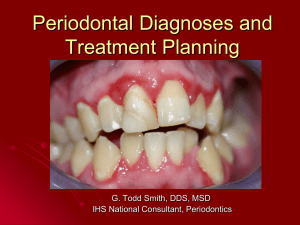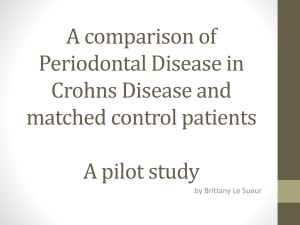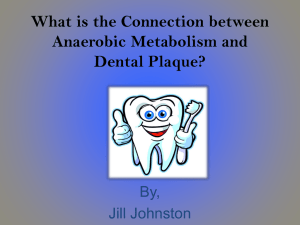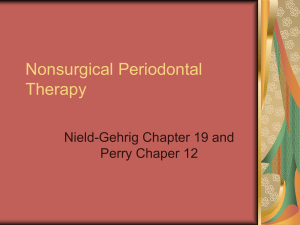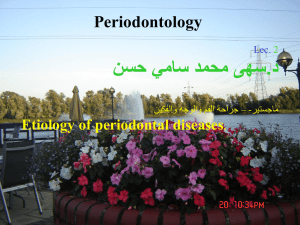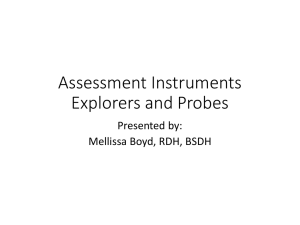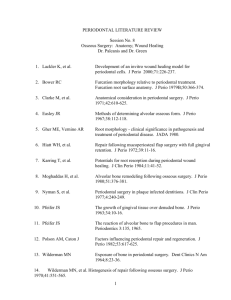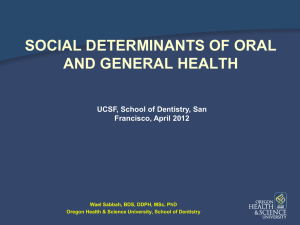Island Dental Colloquium Changing Concepts in Periodontics: What
advertisement
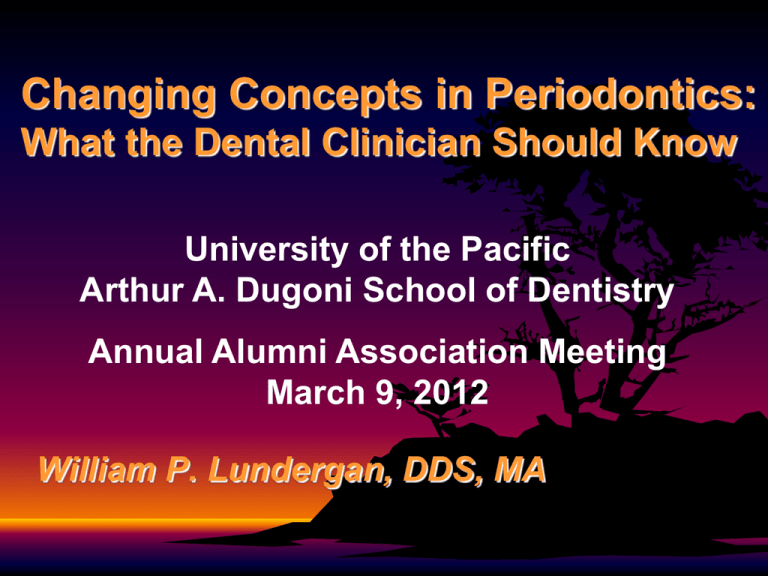
Changing Concepts in Periodontics:
What the Dental Clinician Should Know
University of the Pacific
Arthur A. Dugoni School of Dentistry
Annual Alumni Association Meeting
March 9, 2012
William P. Lundergan, DDS, MA
Today’s Topics
Pathogenesis of periodontal disease
Oral health – systemic health
connection
Periodontal examination, diagnosis and
risk assessment
Periodontal pharmacotherapeutics
Pathogenesis of
Periodontal Disease
1970’s Model
Plaque
Calculus
Pockets
Bone loss
Occlusal trauma
1970’s Model
Gingivitis leads to periodontitis if
untreated
All individuals equally susceptible
Genetics not a factor in adult
periodontitis
Principles of Pathogenesis
1. Bacterial plaque is essential
Experimental Gingivitis
Model
Nonspecific Plaque
Hypothesis
(Plaque Quantity)
Gingivitis
Periodontitis
Experimental Periodontitis
Model
Conclusion:
Conversion from
gingivitis to
periodontitis cannot
be explained by
plaque accumulation
alone.
(Lindhe, 1976)
Possible Conversion Factors
Gingivitis to Periodontitis
Microbiological factors
Host factors
Percentage
of
total viable
bacteria
Predominant Cultivable Microbial Flora
in Gingival Health
SLOTS, 1977
G+ Facultative
Rods and Cocci
Predominantly:
Actinomyces
Streptococci
G- Anaerobic Rods
Predominantly:
Bacteroides
Fusobacteria
Percentage
of total
viable
bacteria
Predominant Cultivable Microbial
Flora in Gingivitis
SLOTS et al. ,1978
70
60
50
40
30
20
10
G+ Facultative
Rods and
Cocci
Predominantly:
Actinomyces
Streptococci
G- Anaerobic
Rods
Predominantly:
Bacteroides
Fusobacteria
Percentage
of total
viable
bacteria
Predominant Cultivable Microbial
Flora in Chronic Periodontitis
SLOTS, 1977
70
60
50
40
30
20
10
G+ Facultative
Rods and Cocci
Predominantly:
Actinomyces
Streptococci
G- Anaerobic Rods
Predominantly:
Bacteroides
Fusobacteria
Specific Plaque
Hypothesis
(Plaque Quality)
Active Microflora
A. actinomycetemcomitans
P. gingivalis
E. corrodens
P. micros
P. intermedia
F. nucleatum
T. forsythia
T. denticola
Data Suggesting
Pathogenicity
Association
Elimination
Host Response
Virulence Factors
Animal Studies
A. naeslundii 2
(A. viscosus)
Subgingival Microbial
V. Parvula
Complexes
A. odontolyticus
S. mitis
S. oralis
P. Intermedia
S. sanguis
C. gracilis
C. rectus
R, nigrescens
P. gingivalis
P. Micros
Stretococcus sp.
S. constellatus
F. nuc. Vincentii
F. nuc. Nucleatum
S. Gordonii
F. nuc. Polymorphum
S. intermedius
F. periodonticum
E. Corrodens
E. nodatum
B. Forsythus
T. denticola
C. showae
C. Gingivalis
C. Sputigena
C. Ochracea
A. actino. b
C. Concisus
A. actino. a
Socransky, J. Clin. Perio, 1998
Biofilms in Peri-Implant Disease
Systematic review
29 papers met criteria
Generally Gm – bacteria similar to CP
Occassional high numbers of
peptostreptococci or staphylococci
Mombelli et al J. Clin Perio., 2011
Viruses and
Periodontal Disease
EBV – 1 and EBV – 2
HCMV
Herpesviruses in Chronic
Periodontitis
40 healthy patients/subgingival
samples
40 CP patients/subgingival samples
Identified bacterial pathogens and
herpesviruses present
Chalabi et al, Mol. Oral Micro., 2010
Herpesviruses in Chronic
Periodontitis (PD > 6mm)
P. gingivalis
T. forsythia
EBV-1
CMV
A. actinomycetemcomitans
EBV-2
95%
75%
72.5%
50%
12.5%
10%
Chalabi et al, Mol. Oral Micro., 2010
Herpesviruses in Chronic
Periodontitis
Authors concluded that EBV-1 and
CMV may play an important synergistic
role in the pathogenesis of chronic
periodontitis
Chalabi et al, Mol. Oral Micro., 2010
Viral Mechanism of
Action
Immune suppression
Encourage overgrowth of pathogens
(enhance attachment)
Interfere with periodontal healing
(fibroblast toxicity)
Cytotoxicity (fibroblasts,macrophages, etc.)
Upregulate cytokines
Contagious
versus
Transmissible
Strong evidence for familial transmission
Little or no evidence infections are
contagious
Transmission of bacteria not
synonymous with transmission of
disease
Principles of Pathogenesis
1. Bacterial plaque is essential.
2. Clinical signs are result of activated
inflammatory and immune
mechanisms.
Principles of Pathogenesis
Bacterial
Challenge
Host
ImmunoInflammatory
Response
Connective
Tissue and
Bone
Destruction
Clinical
Signs of
Disease
Proinflammatory
Mediators
Cytokines
IL–1
IL-6
IL-8
TNF-
PGE2
Matrix metalloproteinases (MMP’s)
Leukotrienes
Principles of Pathogenesis
1. Bacterial plaque is essential.
2. Clinical signs result of activated
inflammatory and immune
mechanisms.
3. Quantity and quality of plaque does
not explain severity of disease by
themselves.
Sri Lankan Tea Workers
(Löe 1986)
• 81% chronic periodontitis
•
8% aggressive form
• 11%
no periodontitis
Principles of Pathogenesis
1. Bacterial plaque is essential.
2. Clinical signs result of activated
inflammatory and immune
mechanisms.
3. Quantity and quality of plaque does
not explain severity of disease by
themselves.
4. Host factors influenced by genetic and
environmental factors.
Twin Studies
Identical twin studies suggest that
more than 40% of the clinical signs
of disease severity are the result of
genetic factors.
Michalowicz et al, J Perio, 1991
IL-1 Genotype
Cumulative %
of subjects
with > 30%
mean bone
loss
Genotype
Pos N=36
Genotype
Neg N=63
35-40
41-45
46-50
51-55
AGE
56-60
>60
J Clin Perio, 1997
Probability of Having Advanced Periodontal Disease:
smoking status
P < 0.004
Former smokers
P < 0.001
Current smokers
0
1
2
3
Odds Ratio
Haber & Kent, J Perio, 1992
4
Principles of Pathogenesis
1.
2.
3.
4.
5.
Bacterial plaque is essential.
Clinical signs result of activated
inflammatory and immune mechanisms.
Quantity and quality of plaque does not
explain severity of disease by themselves.
Host factors influenced by genetic and
environmental factors.
Because of different host responses,
treatment may produce different results in
different individuals.
Pathogenesis of Periodontitis
Page & Kornman,
Periodontol 2000, 1997
Environmental and acquired
Environmental and acquired
(behavioral) risk factors
(behavioral) risk factors
Microbial
Microbial
challenge
challenge
Antibody
Antibody
PolymorphoPolymorphonuclear
nuclear
neutrophils
neutrophils
Antigens
Antigens
LipopolyLipopolysaccharide
saccharide
virulence
virulence
factors
factors
Host
Host
immunoimmunoinflammatory
inflammatory
response
response
Cytokines
Cytokines
&
&
prostanoids
prostanoids
Maxtrix
Maxtrix
metallometalloproteinases
proteinases
Connective
Connective
tissue and
tissue and
bone
bone
metabolism
metabolism
Genetic risk
risk factors
factors
Genetic
Clinical
Clinical
signs of
signs of
disease and
disease and
progression
progression
Oral Health – Systemic
Health Connection
Effect of Systemic Conditions
on Periodontal Health
Endocrine Conditions
Hematologic Disorders
Neutrophil Disorders
Smoking
Medication
Stress
Obesity
Nutrition
Diabetes and Periodontal
Disease
• 2,273 Pima Indians
• 60% prevalence with diabetes
• 36% prevalence without diabetes
Nelson et al, Diabetes Care, 1990
Diabetes and Periodontal
Disease
Poor glycemic control; OR 11.4
for progressive bone loss
Well controlled; OR 2.2
Taylor et al, J. Perio., 1998
Diabetes and Periodontal Disease
AGE - Protein
Macrophage
AGE - receptor
Synthesis + Secretion
TNF - + IL –1ß
Degradative cascade
Stress and
Periodontal Disease
42,523 male health professionals
40-75 years old at baseline
Daily anger
43% higher risk for developing
periodontitis
Merchant et al, JADA, 2003
Stress and Periodontal
Disease
Systematic review
14 of 58 articles analyzed
No meta-analysis
57% found a positive relation
29% found a positive and negative
relation
14% found a negative relation
Peruzzo et al, J. Perio, 2007
Possible Biologic
Mechanisms
1. Poorer Oral Hygiene
2. Stress may alter immune response
• Neutrophil impairment
• Monocyte upregulation
Smoking
Important periodontal risk factor
Increased incidence and severity of
periodontitis
Poorer response to therapy
Associated with NUG
Nicotine can impair neutrophil
function
Decreased BOP
Relative Risk for Periodontitis
Associated with Cigarette Smoking
Current Smoker
Odds Ratio
< 9 / day
2.8
10 – 19 / day
3.0
20 / day
4.7
21 – 30 / day
5.1
> 31 / day
5.9
All
4.0
Tomar and Asma, J. Perio, 2000
Obesity and
Periodontal Disease
NHANES III database
13, 665 subjects (18-34, 35-59, 60-90 y.o.)
Undergone periodontal examination
BMI and waist circumference
Multivariable logistic regression model
Al-Zahrani et al, J Perio, 2003
Obesity and
Periodontal Disease
Significant association for young group
(18-34)
OR 1.0 for BMI 18.5-24.9 kg/m2 (reference)
OR 1.76 for BMI > 30 kg/m2 (P<0.01)
OR 0.21 for BMI < 18.5 kg/m2 (P<0.01)
OR 2.27 for high waist circumference
(P<0.001)
Al-Zahrani et al, J Perio, 2003
Obesity and
Periodontal Disease
Obesity could be a potential risk
factor for periodontal disease,
especially among younger
individuals
Al-Zahrani et al, J Perio, 2003
Low Serum Calcium and
Periodontal Disease
NHANES III
11,787 subjects age 20 to 90+
Age groups (20-39; 40-59; 60+)
OR 6.11 for females (20-39 y.o.) P<0.001
OR 2.18 for females 60+ P<0.13
Nishida et al, J. Perio, 2000
Periodontal Disease
Odds Ratio (95% C.I.)
2.0
Female
Male
1.5
1.0
0.5
n=1654
n=1504
n=2666
n=2750
n=1813
n=2032
2-499
500-799
800+
2-499
500-799
800+
0.0
Dietary Calcium Intake (mg)
Nishida et al, J. Perio, 2000
Conclusion
Results suggest that low dietary intake
of calcium results in more severe
periodontal disease
Nishida et al, J Perio, 2000
Vitamin D and Calcium
Cross- sectional study
51 periodontal maintenance patients
23 vitamin D supplements (> 400 IU / day)
calcium supplements (> 1000 mg / day)
6.3 to 23 years of supplementation
28 no vitamin D or calcium supplements
Clinical and radiographic measurements
taken
Repeated measures multivariate analysis
Miley el al, J. Perio, 2009
Vitamin D and Calcium Intake
Measurement
Probe depths (mm)
LOA (mm)
Bleeding sites (%)
Gingival Index
Furcation Involvement /
molar sites (%)
Calcium intake (mg/day)
Vitamin D intake (IU/day)
Takers
Non-Takers
2.18
1.80
60
0.73
47
2.33**
2.01**
66**
1.00**
72**
1,769
1,049
642*
156*
* P<0.01
** P>0.05
Miley el al, J. Perio, 2009
Treatment Considerations
for Periodontal Patients
Control pathogens
Modulate host response
Smoking cessation program
Good glycemic control
Stress reduction protocol
Weight reduction program
Calcium supplementation
Genetic assessment
Systemic Effects of Periodontitis
Cardiovascular Disease
Pregnancy
Diabetes Mellitus
Respiratory Disease
Cardiovascular Disease
and Periodontitis
Suppose you could prevent a
heart attack with a 2 minute, no
sweat exercise that could be
performed anywhere.
Would you be interested?
Flossing your teeth might
be an exercise that saves
your life.
Cardiovascular Disease /
Periodontal Disease
1,147 subject cohort
Systemically healthy at enrollment
18 year follow-up
Bone loss and CHD (OR 1.5)
Bone loss and fatal CHD (OR 1.9)
Bone loss and stroke (OR 2.8)
Beck et al, J. Perio., 1996
Other Risk Factors
Cholesterol and CHD (1.6 OR)
Smoking and fatal CHD (1.7 OR)
Smoking and stroke (1.6 OR)
Family Hx. CHD and stroke (3.5 OR)
Annals of Perio, 1996
Incidence of CHD by Level of Oral Bone Loss
%
50
40
30
20
10
0
None
<20%
20-40%
>40%
Age adjusted level of bone loss
Adapted from Beck et al., 1996
Cardiovascular Disease /
Periodontal Disease
8032 subjects (NHANES I)
Aged 25 – 74
21 year follow-up
Gingivitis and CHD (OR 1.05)
Periodontitis and CHD (OR 1.14)
Hujoel et al., JAMA, 2000
Biologic Plausibility
Bacteremia and Brushing
290 patients in need of an extraction
Double blind; random assignment to 3
tx. Groups
Brushing / extraction-Amoxicillin /
extraction-Placebo
Blood draws at baseline, 1.5 minutes
and 5 minutes after initiation and 20,
40, 60 minutes after completion
Circulation, 2008
Brushing
60
Extraction-Amox
Extraction Placebo
% Positive Cultures
50
40
30
20
10
0
1
2
3
4
Draw
5
6
Cardiovascular Disease
/ Periodontal Disease
50 atheromatous plaque specimens
(endarterectomy)
70% atheromas were positive for bacterial
DNA
44% positive for periodontal pathogens
30% T. forsythia
26% P. gingivalis
18% A. actinomycetemcomitans
Haraszthy et al., J. Perio, 2000
Systemic exposure to bacteria, endotoxin,
and cytokines of periodontal origin may
contribute to atheroma development and
thromboembolic phenomena.
LPS
Upregulates endothelial adhesion
molecules
Releases cytokines favoring coagulation
and thrombosis
Retards fibrinolysis
Enhances smooth muscle proliferation
Chewing & Endotoxemia
40% of patients with Periodontitis
positive
12% of perio healthy patients positive
Serum concentration of endotoxin 5x
greater in periodontitis patients
Geerts et al, J. Perio 2002
Monocytic/Lymphocytic
Response Trait
Genetic Factors
Environmental Factors
Hyperinflammatory
Phenotype
Periodontal
Pathogens
Periodontal
Disease
Atherosclerosis
Predisposition
Other
Risk
Factors
•Atherosclerotic lesion
development
•Thrombroembolic
events
Microbial and
LPS exposure
PGE2 , IL-
TNF-
Vascular Effects
•Endothelium
•Smooth muscle
•Platelets
Beck et al, Annals of Perio, 1998
Periodontal Disease and
Cardiovascular Disease
Systematic review
31 studies analyzed
Different oral assessment measures
No meta-analysis
Scannapieco, Annals of Perio, Dec. 2003
Consensus Report:
There is moderate evidence to suggest
that periodontal disease is associated
with cardiovascular disease, however,
causality is unclear
There is currently insufficient evidence
to show that treatment of periodontal
disease reduces the risk of heart disease
Annals of Perio, Dec. 2003
Endothelial Function &
Periodontal Treatment
114 subjects with 30% bone loss on over
50% of their teeth and PD over 6mm
(Control) OHI / Supragingival plaque removal
(Test) Sc/RP with anesthesia; selective
extraction; Arestin
Brachial artery dilatation / flow measurement
Tonetti et al, N Eng J of Med, 2007
Endothelial Function &
Periodontal Treatment
Sc/RP led to short term (24 hr.)
systemic inflammation & endothelial
dysfunction.
Six month endothelial function was
improved compared to the control
(P<0.001).
Tonetti et al,
N Eng J of Med, 2007
Periodontal Disease and
Carotid Plaque
FDG – PET measures metabolic
activities in human tissues
Hypothesis: metabolic activities in
periodontal tissue predicts
inflammation in remote atherosclerotic
vessels
Fifer et al, J. Am. Coll. Cardiology, 2011
Periodontal Disease and
Carotid Plaque
112 patients underwent FDG – PET
imaging
Measured uptake in periodontal tissues
and carotid / aorta vessels
16 patients underwent carotid
endarterectomy within 1 month of
imaging
Fifer et al, J. Am. Coll. Cardiology, 2011
Periodontal Disease and
Carotid Plaque
Periodontal FDG uptake associated
with carotid (R=0.64) and aortic
(R=0.38) uptakes
Strong relationship (R=0.81) between
periodontal uptake and histologically
assessed inflammation (macrophage
infiltration) within excised carotid
artery plaques
Fifer et al, J. Am. Coll. Cardiology, 2011
Periodontal Disease and
Carotid Plaque
Authors concluded this study may set
the stage for future investigations
regarding the effect of treatment of
periodontal disease on carotid plaque
inflammation.
Fifer et al, J. Am. Coll. Cardiology, 2011
Periodontal Disease and
Preterm Birth
124 women
< 2,500 gm. Birth
< 37 weeks gestational age
Preterm labor
Premature rupture
Periodontal disease and PLBW (OR 7.9)
Offenbacher et al; J. Perio, 1996
Risk Factors for PLBW Mothers
Periodontitis
Alcohol
AfricanAmerican
Age
Parity
Treated BV
0
1
2
3
4
5
6
7
Odds Ratio
Annals of Perio, 1998
8
Biological Plausibility
Periodontal
Disease
Inflammatory
Response
Mediators
PGE2 TNF-
Uterine Contraction
Cervical Dilation
Mean Litter Weight {g}
Experimental Periodontitis / Hamster
Model
2
1.9
1.8
1.7
1.6
1.5
1.4
1.3
1.2
1.1
1
Control
Annals of Perio., 1998
Control
+ P. ging
Chow
Chow+P.ging
Periodontitis
Intraamniotic Levels (ng/mL)
Experimental Periodontitis / Hamster
Model
14000
12000
10000
8000
PGE2
6000
4000
2000
PGE2
TNF-
TNF-
0
Control
Periodontitis
Annals of Perio., 1998
Oral Conditions and
Pregnancy
5 yr. Prospective study
Full mouth perio exam
812 deliveries
566 mild periodontitis
45 moderate to severe periodontitis
201 healthy
Annals of Perio, 2001
% of
Births
*
100%
90%
80%
70%
60%
50%
40%
30%
20%
10%
0%
†
BW (g)
<1000
1000-1999
2000-2499
>2500
Health
Mild
ModerateSevere
Maternal Antepartum Periodontal Status
* P = 0.0006
† P <0.0001
Annals of Perio, 2001
Percent of Fetal IgM Responses Against Orange
and Red Complex Organisms Among Term and
Preterm Neonates
Term
Organisms
(n = 271)
Preterm
(n = 80)
P Value
Orange Complex
C. Rectus
P. Intermedia
6.3
1.1
20.0
8.8
0.0002
0.0003
16.2
10.7
8.1
16.3
20.0
17.5
>0.05
0.03
0.015
Red Complex
P. Gingivalis
B. Forsythus
T. Denticola
Annals of Perio, 2001
Periodontal Disease and
Adverse Pregnancy
Outcomes
Systematic review
12 studies analyzed
No meta analysis
Scannapieco et al, Annals of Perio., Dec. 2003
Consensus Report:
There is moderate evidence to suggest that
periodontal disease is associated with
adverse pregnancy outcomes, however
causality is unclear
There is currently limited evidence to
recommend that patients undergo
periodontal treatment to reduce the risk of
adverse pregnancy outcomes
Annals of Perio., Dec. 2003
Periodontal Therapy and
Preterm Birth
N = 870 women (Santiago, Chile) with periodontal
disease
Baseline exam
Random assignment
Treatment before 28 weeks or after delivery
OHI daily CHX rinses, mechanical debridement, 2-3
week maintenance (18% systemic antibiotics)
Control group monitored at 4-6 weeks
Lopez et al, JP, 2005
Periodontal Therapy and
Preterm Birth
2.1% (12/560) preterm (treatment
group)
6.7% (19/283) preterm (control group)
OR 2.76; p = 0.008
Lopez, JP, 2005
Preterm Birth & Periodontal
Treatment
Multi-centered / randomized
823 women
“essential” dental care for all
413 women received Sc/RP
No significant difference between
groups in mean gestational age
Michalowicz et al,N Eng J of Med, 2006
Mouth Rinse and Preterm Birth
204 women 6-20 weeks gestation
All had periodontal disease diagnosis
All refused standard dental care
Random group assignment
Blinded examiners
Jeffcoat, IADR, 2011
Mouth Rinse and Preterm Birth
49 subjects used Crest Pro-Health rinse
155 used identical bottles of water
No significant difference in tobacco or
alcohol use between groups
Preterm birth defined as less than 35 weeks
Jeffcoat, IADR, 2011
Mouth Rinse and Preterm
Birth
6.1% preterm birth (test group)
21.9% preterm birth (control group)
P < 0.01
Periodontal disease remained constant
in test group
Periodontal disease progressed in the
control group
Jeffcoat, IADR, 2011
Diabetes and Periodontal
Disease
Periodontitis may adversely affect
glycemic control in diabetes
Control of periodontal inflammation
may reduce medication needed for
glycemic control.
Treatment of Periodontal
Disease in Diabetes
• Thorough root cleaning
• Doxycycline 100 mg daily / 2 wks.
12 Months Post-Treatment
Improved CAL
Reduced PD
Improved glycemic control
Grossi et al, J. Perio, 1997
After Periodontal Treatment
Mean Change of HbA1C (%)
No Doxycycline
1
Doxycycline
P. Gingivalis positive
P. Gingivalis negative
0.5
0
-0.5
-1
Grossi et al, J. Perio, 1997
CIGNA Study
3 year study reviewing CIGNA records
46,094 individuals aged 18-62
3,449 received treatment for diabetes
IADR, 2011
CIGNA Study
Group 1: perio treatment at baseline and
regular maintenance (1,355)
Group 2: perio treatment prior to baseline
without regular maintenance (2,094)
Group 2 had average medical cost of
$2,483.00 per patient greater than Group 1
IADR, 2011
Periodontal Disease &
Respiratory Disease
Nursing home residents
Oral care vs. no oral care
11% vs. 19% incidence of pneumonia
8% vs. 16% pneumonia related mortality
Yoneyama et al, J. Am. Geriatr. Soc., 2002
Oral Hygiene Intervention /
Pneumonia
Systematic review
Meta-analysis / odds ratios
N=497 (5 studies); OR=3.7
Scannapieco et al, Annals of Perio., Dec. 2003
Consensus Report
Moderate evidence suggests that the
incidence of noscomical pneumonia in
institutionalized subjects, including
those of intensive care units and nursing
homes, may be reduced by improving
oral hygiene, which can be achieved by
both mechanical or chemical approaches
Annals of Perio., Dec. 2003
Summary
We must now consider that
periodontal infections may
also play a significant role in
systemic health.
Periodontal Examination,
Diagnosis and Risk
Assessment
Non-diagnosis, under
treatment and inappropriate
treatment of periodontal
disease are major causes of
tooth loss.
All patients must be
screened on a regular basis,
with comprehensive exams
when disease is detected.
Periodontal Screening and
Recording (PSR)
Screening exam designed jointly by the
AAP and ADA
Promotes early detection and tx
Allows rapid assessment and recording
Does not replace the need for a
comprehensive periodontal exam
W.H.O. probe
0.5 mm ball tip
3.5 mm and 5.5 mm markings
Scores by sextant
Six sites per tooth
Highest score recorded per sextant
An * added if other clinical abnormalities
Parameters of Care
Periodontal examination
Periodontal diagnosis
Informed consent
Re-evaluation
Periodontal maintenance
J. Perio Supplement, May 2000
Parameter on
Comprehensive Periodontal
Examination:
Med. Hx.
Dent. Hx.
EOE & IOE
Radiographs (current)
Teeth evaluated (caries, mobility, etc.)
Plaque and calculus presence and
distribution
Parameters of Care, 2000
Parameter on
Comprehensive
Periodontal Examination:
PD, GM, BOP evaluated
Mucogingival relationships
Furcations (presence, location, extent)
Clinical findings documented
Referral when warranted
Parameters of Care, 2000
Diagnosis should be based on
clinical attachment level and not
probing depth.
Probing Depth
Measurement
Rapidly recorded
Good assessment of disease
distribution in patient
Limited diagnostically
Essential part of complete exam
Clinical Attachment
Loss Measurements
Difficult to measure
Important diagnostic value
Most valued assessment of treatment
outcome
Clinical Attachment Level
Assessment
Facial / lingual (locate CEJ / perio probe)
Interproximal (look at radiograph); clinically
estimate CEJ based on facial and lingual
location
Normal Osseous Form
Normal bone
Radiographically
normal bone
height
Bleeding on Probing (BOP)
Indicates inflammation
Not reliable predictor LOA
No Bleeding on Probing
Reliable predictor no LOA
Repeated absence highly predictive
Smoking and Bleeding
NHANES III survey
12,385 individuals
141,967 sites
Dietrich et al, J.P. 2004
Weighted Odds Ratio (OR) from the Main
Effects Model*
Smoking Status
OR
Never
1.00
Former
0.78
Current (cigarettes/day)
< 10
0.53
11 – 20
0.40
21 – 30
0.33
> 30
0.44
* Adjusted for age, gender, race/ethnicity, calculus, probing depths, poverty /
income ratio, tooth / jaw, number of missing teeth, full crown coverage, root
caries, dental examiner, survey phase, stratum, and PSU.
PD 0-3 mm
6
no calculus
5
supra
4
OR
sub / supra
3
2
1
0
Never
Former
Light
Heavy
Weighted OR estimates showing the effect of smoking status on gingival bleeding
by calculus for sites with probing depths (PD) of 0 to 3 mm (reference: sites with
PD 0 to 3 mm without calculus in never-smokers).
PD > 4 mm
6
no calculus
5
supra
4
OR
sub / supra
3
2
1
0
Never
Former
Light
Heavy
Weighted OR estimates showing the effect of smoking status on gingival bleeding
by calculus for sites with probing depths (PD) of > 4 mm (reference: sites with PD
0 to 3 mm without calculus in never-smokers).
Smoking and Bleeding
Bleeding on probing reduced nearly
50% in smokers
Effects strongest in heavier smoker
Smallest in former smokers
May mask periodontal disease
Dietrich et al, J.P. 2004
Implant Assessment
Plastic probes are used
when checking for evidence
of disease.
Implant Baseline
Examination
Baseline radiographs
Baseline probing assessment
Seventh European Workshop on Periodontology
J. Clin. Perio. 2011
Maintenance Visits
Occlusion - verify there are no excursive contacts.
Should not have contact in light occlusion but
mark with hard biting.
Oral hygiene - same requirements as for natural
teeth.
Soft tissue health - periodontal probing for
evidence of disease (check BOP each recall).
Screw joint torque - check for loosened screws
(most common problem).
Integrity of attachments - applies to overdenture /
overpartials.
Stability of implants - must be stable (non mobile)
to be successful
Crestal bone level – annual radiographs
Biologic Parameters
Microbial Analysis
Culture
DNA probe
Genetic Susceptability
IL-1
GCF analysis
Host derived enzymes
Inflammatory mediators
Tissue breakdown products
Neutrophil Function Assays
Chemotaxis
Phagocytosis
Microbial Analysis
A diagnosis and treatment
plan should be presented
to the patient.
Parameters of Care, 2000
Parameter on
Comprehensive
Periodontal Examination:
Informed consent
Diagnosis
Treatment alternatives
Potential complications
Expected results
Consequences of no treatment
Patient responsibilities
Parameters of Care, 2000
Periodontal
Pharmacotherapeutics
Periodontal
Pharmacotherapeutics
Topical
Local
Irrigation
Sustained release
Systemic
Comparison of Drug Delivery Systems
for Management of Periodontitis
Mouth
Rinse
Subgingival
Irrigation
Systemic Controlled
Delivery Delivery
Reaches site of
disease activity
Poor
Good/Poor
Good
Adequate drug
concentration
Good
Good
Fair/Good
Good
Adequate duration
of therapy
Poor
Poor
Fair/Good
Good
Good/Poor
Topical Delivery
First Generation
Antimicrobial
Antimicrobial Agents
Phenolic compounds
Peroxide
Enzymes
Fluoride
Quaternary ammonium compounds
Sanguinarine
Alexidine
Octinidine
Chlorhexidine
Triclosan / Copolymer
Antimicrobial Spectrum of Antiseptic Agents
Group
Gram positive
Gram negative
Fungi
Viruses
Alcohol
+++
+++
+++
+++
Chlorhexdine
+++
++
+
+++
Iodine
compounds
+++
+++
++
+++
Iodophors
+++
+++
++
++
Phenol
derivatives
+++
+
+
+
Triclosan
+++
++
-
+++
+
++
-
+
Quaternary
ammonium
compounds
Note:
+++ = excellent
++ = good
+ = fair
- = no activity or not sufficient
CDC 2004
Salivary Concentration
ug/ml
1,000
Mouthwash
(No Substantivity)
100
10
Expectoration
nd
2
Generation Antimicrobial
Salivary Concentration
ug/ml
Substantivity
1000
Chlorhexidine
(Substantivity)
100
10
12 hours
Expectoration
Plaque Index
Lang and Brecx, JPR 1986
2
1
0
0
0.12% CHX
Sanguinarine
7
14
0.075% CPC
Placebo
DAYS
21
Listerine
Gingival Index
Lang and Brecx, JPR 1986
2
1
0
7
0
0.12% CHX
sanguinarine
0.075% CPC
14
Placebo
Listerine
DAYS
21
Control
(10 days)
Octinidine
(10 days)
New Product
Delmopinol HCl 0.2%
PerioShield / Sunstar
Reduce viscosity of
plaque glucans
Forms barrier
interfering with
bacterial aggregation
and colonization
®
Total
Toothpaste
• Triclosan
• Copolymer
PVM/MA
®
Total
Dual antibacterial/anti-inflammatory action
12 hrs antibacterial action
27% plaque reduction
57% gingivitis reduction
37% decrease in supragingival calculus
Membrane Phospholipids
Phospholipase A2
Arachidonic Acid
Cox 1 & 2
5 - lipoxygenase
Triclosan
Triclosan
Prostaglandins
Leukotrienes
Cell-Cell
interaction
Lipoxins
Local Delivery
Irrigation
Patient
Delivered
Irrigation
Professional Irrigation
How far subgingivally do
irrigants extend?
Supragingivally –
only a few
millimeters at best
Subgingivally –
much more
Consensus Report:
There is strong evidence for a lack
of an adjunctive benefit of
therapist delivered chlorhexidine
irrigation during SRP to achieve
reductions in PD and BOP in
patients with chronic periodontitis
Annals of Perio, Dec. 2003
Local Sustained Release
Actisite
PerioChip
Atridox
Arestin
Local Sustained Release
May produce marginal improvements in:
Attachment
levels
Probing depths
Gingival bleeding
Perio Chip
2.5 mg chlorhexidine gluconate
4 mm x 5 mm x 350 um chip
<1 minute to insert
No bacterial resistance
Controlled release
Bioabsorbable
®
Pharmacokinetics
40%
released within 24
hrs.
>1,000 ug/ml at 4 hrs.
480 ug/ml at 3 days
®
Atridox
Controlled –release product
Doxycycline hyclate (10%)
50 mg doxycycline
2 syringe system
Coe-Pak/Octyldent
Bioabsorbable
Doxycycline
Broad-spectrum
Bacteriostatic
MIC90
< 6.0 ug/ml
Pharmacokinetics
2000
1750
1500
1250
Coe-Pak
Octyldent
1000
750
500
250
0
0
2
8
12
18
24
Time (Hours)
48
72
120 168
Arestin
minocycline 1 mg.
microsphere technology
bioabsorbable
easy to place/use
No
reconstitution
No refrigeration
sustained drug delivery
Arestin Polymer PGLA
Characteristics
Bioadhesive
Bioabsorbable
No retentive dressing
necessary
Hydrolyzes to CO2
and H2O – nothing
to remove
Proven Safety
Suture Material
Minocycline
Potent, broad spectrum antibiotic
Semi-synthetic derivative of tetracycline
Effective against periodontal pathogens
Periodontal Pathogens
MIC90
(mcg/ml)
Bacteroides
4
Porphyromonas Gingivalis
Actinobacillus Actinomycetemcomitams
Prevotella Intermedia
Treponema Denticola
1
4
4
0.06
Pharmacokinetics
How To Use
Chair-side Preparation
How To Use
Remove Tip from Cartridge
How To Use
Place Subgingivally
Probing Depth Reduction (Clinical Attachment Gain) With
Local Drug Delivery (mm)
Study
N
SC/RP
Combined
Number of
Applications
Chlorhexidine Chips
Jeffcoat et al
447
0.64 (0.51)
0.95 (0.75)
1 to 3
Soskolne et al
118
0.70 (0.31)
1.16 (0.47)
2
Minocycline Microsphere
Williams et al
696
3
Probing depth > 5 mm
1.08
1.32
Probing depth > 6 mm
1.05
1.46
Probing depth > 7 mm
0.98
1.99
411
1.3 (0.8)
1.3 (0.9)
2
411
0.9 (0.8)
1.1 (0.9)
2
Doxycycline Hyclate
Garret et al
Local Anti-Infective
Therapy: Pharmacological
Agents
Systematic review
32 studies
Patient’s with chronic periodontitis
Meta-analysis for PD and CAL
Scannapieco et al, Annals of Perio., Dec. 2003
Consensus Report:
There is moderate evidence to
demonstrate a statistically
significant benefit associated with
the adjunctive use of minocycline
microsphere, combined with SRP
to achieve additional PD reduction
Annals of Perio, Dec. 2003
Consensus Report:
There is moderate evidence to
demonstrate a statistically significant
benefit associated with the adjunctive
use of chlorhexidine chip and
doxycycline gel combined with SRP for
additional CAL gain
Annals of Perio, Dec. 2003
Consensus Report:
There is strong evidence that the
adjunctive use of local delivery
anti-infective intracrevicular
agents combined with SRP does
not result in significant patient
centered adverse events.
Annals of Perio, Dec. 2003
Systemic Therapy
Antibiotics
Probiotics
Host
modulation
Antibiotic Therapy
Systemic antibiotics may be
indicated for:
Aggressive periodontitis
Refractory periodontitis
Acute infections
Diabetes
Implants
Antibiotic Therapy
Systemic antibiotics not
indicated for:
Chronic periodontitis
NUG
Typical Antibiotics Used For
Treating Periodontitis
Drug
Metronidazole
Ciprofloxacin
Metronidazole &
amoxicillin
Metronidazole &
ciprofloxacin
Doxycycline
Clindamycin
Adult Dose
500 mg/TID/8 days
500 mg/BID/8 days
250 mg/TID/8 days of
each drug
500 mg/BID/8 days of
each drug
100 – 200 mg/QD/21
days
300 mg/TID/8 days
Position Paper (AAP) J Perio, 2004
Periodontal Abscess
Typical Antibiotics Used for
Treating a Periodontal Abscess
Amoxicillin
1.0 g. LD; 500 mg., t.i.d.; 3 days
Azithromycin
1.0 g. LD; 500 mg. daily on days 2 and 3
Clindamycin
600 mg. LD; 300 mg; q.i.d.; 3 days
Position Paper (AAP) J Perio, 2004
Probiotics and Periodontal
Disease
66 medically healthy volunteers without
severe periodontitis
Random assignment / double blind
Lactobacillus salivarius and Xylitol tablet
(n=34)
Placebo Xylitol tablet (n=32)
T.I.D. for 8 weeks
Mayanagi et al, J Clin Perio, 2009
Probiotics and Periodontal
Disease
Supragingival and subgingival plaque
samples taken at baseline, 4 wks., and 8 wks.
for 5 periodontal pathogens
Numerical sum of pathogens in test group
subgingival plaque was decreased
significantly at 4 wks (OR=3.13; p=0.012)
Tannerella forsythia lower subgingivally in
test group vs. placebo at 4 wks (OR=6.69;
p<0.001) and 8 wks (OR=3.67; p=0.006)
Mayanagi et al, J Clin Perio, 2009
Host
Modulation
Therapy
Pathway to Periodontal
Disease
Environmental and
and acquired
Environmental
acquired
(behavioral) risk
risk factors
(behavioral)
factors
Antibody
Antibody
Cytokines
Cytokines
Host
Host
Connective
Connective
&
PolymorphoPolymorphoMicrobial
Microbial
prostanoids tissue
immuno- prostanoids
immunotissueand
and
nuclear
nuclear
challengeneutrophils
challenge
inflammatory
inflammatory
neutrophils
bone
bone
response
response
metabolism
metabolism
Antigens
Antigens
LipopolyLipopolysaccharide
saccharide
virulence
virulence
factors
factors
Maxtrix
Maxtrix
metallometalloproteinases
proteinases
Geneticrisk
risk factors
Genetic
factors
Clinical
Clinical
signs
of of
signs
disease
and and
disease
progression
progression
Periostat
Doxycycline hyclate
20 mg. Capsules
Twice daily
Chronic dosing
Periostat
Adjunct to Sc/RP
Anti-collagenase activity
No shift in microflora
No emergence of resistant flora
Sub-Antimicrobial Dose
Doxycycline (SDD)
Systematic review
Patients with chronic periodontitis
SDD with Sc/RP vs. Sc/RP alone
Meta-analysis CAL and PD
N=691 (6 studies) / PD 4-6mm / CAL 0.44mm /
PD 0.45
N=664 (5 studies) PD > 7mm / CAL 0.45mm /
PD 0.48
P < 0.005
Reddy et al, Annals of Perio, Dec. 2003
Consensus Report:
There is strong evidence supporting the
use of SDD as an adjunct to
conventional therapy in the
management of chronic periodontitis
Annals of Perio, Dec. 2003
NSAID’s
Indomethacin
Flurbiprofen
Ibuprofen
Naproxen
Ketoprofen
NSAID’s
Decreases rate of bone loss
Decrease BOP
Decrease gingival inflammation
Inhibit LOA
Membrane Phospholipids
Phospholipase A2
Arachidonic Acid
Cox 1 & 2
5 - lipoxygenase
NSAID’s
Ketoprofen
Prostaglandins
Leukotrienes
Cell-Cell
interaction
Lipoxins
Bisphosphonates
Alendronate vs. placebo
40 subjects with periodontitis
Double blind, randomized
Subtraction radiography
0.45 relative risk of progressive bone
loss for alendronate
Jeffcoat et al, 1996
THE END

